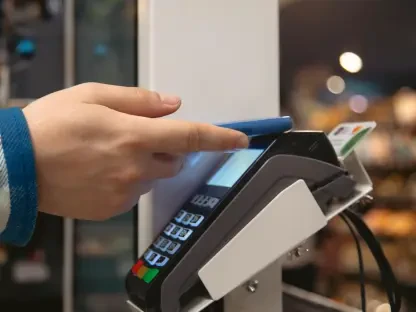The retail sector is currently grappling with a perilously steep ascent in fraudulent activities, leading to monumental financial losses and a profound impact on consumer trust. As these crime rates swell, understanding the intricacies of fraud in the retail realm becomes not just advantageous, but a necessity for survival. With the correct implementation of cutting-edge technologies and insightful data analysis, retailers have the opportunity to dampen the effects of these criminal endeavors while preserving, or even enhancing, the overall shopping experience.
The Mounting Threat of Retail Fraud
In an unsettling trend for the industry, retail fraud is skyrocketing, inflicting severe financial harm and undermining the integrity of customer service. These illicit activities range from simple shoplifting to sophisticated scams and pose a daunting challenge for retailers around the globe. Analyses suggest that economic hardships, augmented by inflation and challenging employment landscapes, may have spurred the recent increase in fraud. Additionally, the role of social media in propagating successful thievery techniques has become a double-edged sword; while it connects people, it also serves as a platform for the rapid dissemination of exploits and tactics among opportunistic fraudsters. Retailers must, therefore, comprehend this multifaceted threat to develop solid strategies against it.Fraudulent schemes have evolved well beyond mere shoplifting, growing into a complex array of methods designed to exploit various aspects of the retail process. This escalation hasn’t just damaged profit margins but has also cast a lingering shadow on retailers’ ability to preserve quality service. Economic phenomena such as inflation, along with a grueling job market, are cited as catalysts fueling this troubling ascent. The culprits behind this surge are varied, from individual opportunists to well-organized syndicates, and their methods are continually evolving. Furthermore, the ubiquity of social media serves as a catalyst, with successful theft tactics effortlessly shared and mimicked at unprecedented rates. Understanding these factors is critical for retailers seeking to mitigate the upswing in fraudulent activity effectively.
Understanding Diverse Fraud Typologies
Within the diverse realms of fraud typologies, each one presents unique puzzles. From the rudimentary ‘sliding’ technique where barcodes are obscured to elude scanning, to the complexities of return and loyalty fraud, it is abundantly clear that fighting fraud is akin to a multi-front battle. The adaptability of fraudsters mandates that retailers remain vigilant and consistently refine their strategies. Broadening our understanding of these schemes is paramount, as it conditions retailers to be proactive in evolving their prevention tactics. It is a game of cat and mouse, where the mice are inventive and unrelenting, necessitating constant innovation from the cats — the retailers.With the increasing sophistication of fraudsters, retailers face the inevitability of perpetuating the cat-and-mouse chase. Techniques such as ‘sliding’ and ‘price switching,’ along with the covert complicity of ‘sweethearting’ between employees and customers, highlight the resourcefulness of deceit. Additionally, organized retail crime rings engage in broader, more systemic fraud, often spanning multiple locations or retailers. Transaction fraud utilizing stolen payment details, the manipulation of return policies, and the misuse of loyalty programs further underscores the labyrinthine nature of retail fraud. This understanding is critical for retailers to adapt and formulate nuanced defense strategies.
Individualizing Fraud Prevention Strategies
In the quest to confront fraud, a personalized approach, tailored to the intricate nature of each fraud type, holds the key to success. Retailers are thus implored to utilize their proprietary data, gathering intel from various touchpoints, like in-store transactions and online sales, to construct a bespoke shield against fraud. Harnessing the specifics from point-of-sale records, inventory management, and customer interactions enables the creation of a comprehensive picture of potential vulnerabilities. Recognizing that fraud patterns differ greatly from one operation to another, retailers can chart a path that’s grounded in their individual retail landscape.The use of bespoke loss prevention systems allows for a strategic defense against the multiplicity of fraudulent methods. By analyzing their data, retailers can pinpoint specific trends and risks, leading to informed and effective countermeasures. The data drawn from diverse sources should be coalesced, painting an all-encompassing picture of a retailer’s exposure to fraud. Such proactive scrutiny can reveal critical weak spots, whether they stem from cashier mishandling, inventory shrinkage, discount abuse, or otherwise. This nuanced understanding paves the way for bespoke solutions, expertly aligned with a retailer’s unique operational needs.
Adaptive Countermeasures against Fraud
In grappling with the wily nature of schemers, it is clear that the battle against fraud is one of evolution, not absolutes. From reeducating staff on policy adherence to leveraging advanced surveillance technology, each measure should reflect the retailer’s specific fraud concerns. The metamorphosis of self-checkout systems, some completely revamping their operations, punctuates the industry’s push toward greater oversight without stifling customer convenience. The adaptive nature of these countermeasures aims to curb losses while offering a streamlined, if not improved, customer service experience.In this adaptive battle against illicit activity, the spectrum of countermeasures must remain versatile and evolving. Retailers may reassess employee guidelines concerning discount applications, heightening the focus on deterring internal fraud, all while surveillance tech observes the shopping floor, leveraging AI to spot anomalies. Suggestions of modifying self-checkout accessibility by restricting operational hours or their presence point to a strategic calculus balancing control of fraud with a consistent customer experience. The aim of these varied approaches remains constant: to deploy adaptive strategies that can proficiently curb retail fraud’s increasing impact.
Data-Driven Approaches for the Future
Retail’s future in combating fraud lies irrevocably in the data-driven realm. Surging ahead with data at the helm, retailers can better anticipate shifts in fraudulent behavior and adjust accordingly. Emphasizing the significance of this approach invites exploration into enhanced AI and machine learning techniques for fraud detection. A continuous iteration from scalable solutions towards intricate arrangements signifies a forward-looking stance that could redefine the industry’s resistance to fraud.The pathway toward preempting retail fraud is charted by the astute application of data analytics. By leveraging prevailing data streams, retailers can fine-tune their fraud prevention strategies with precision. Extensive datasets can fuel sophisticated AI models, potentiating a world where machine learning not only detects fraud in real-time but possibly predicts and thwarts even the most avant-garde schemes. The transition from modest interventions to AI-bolstered defense systems represents a deliberate, yet necessarily gradual, evolution—heralding a proactive, data-led future in loss prevention.
Balancing Security with Customer Satisfaction
The retail industry faces an uphill battle against surging fraudulent activities that threaten not only their financial stability but also customer trust. As fraud rates rise, it’s critical for businesses to understand the details of these crimes. Survival now hinges on effectively using advanced technologies and analytics to stem the tide of fraud. By adopting these measures, retailers can mitigate the impact of fraud while ensuring that consumers continue to enjoy a positive shopping experience. The challenge lies not simply in addressing fraud, but in proactively safeguarding against it to protect their bottom line and consumer confidence. As the stakes get higher, the role of innovative solutions and strategic data usage becomes central to the future of retail security.









